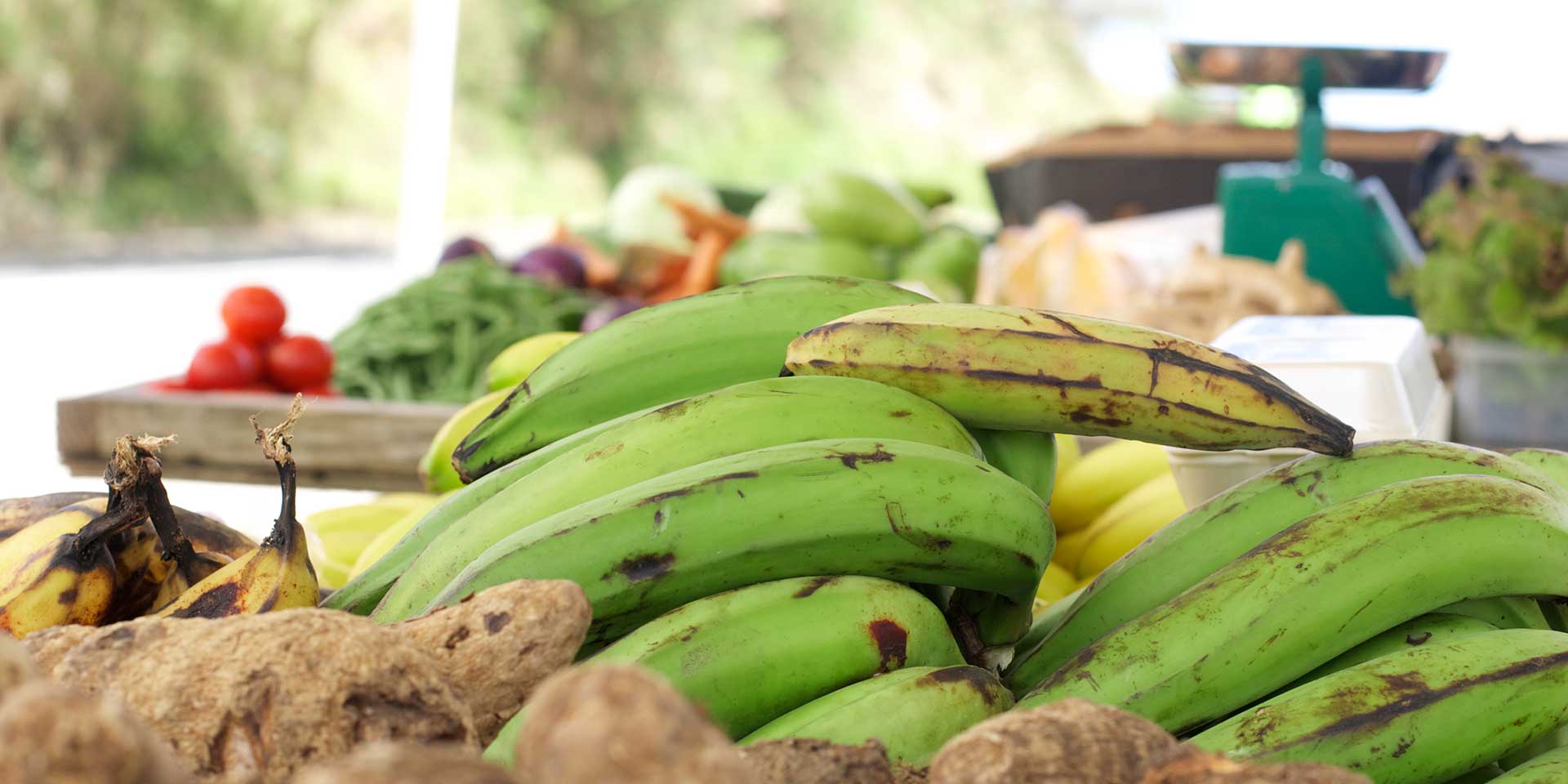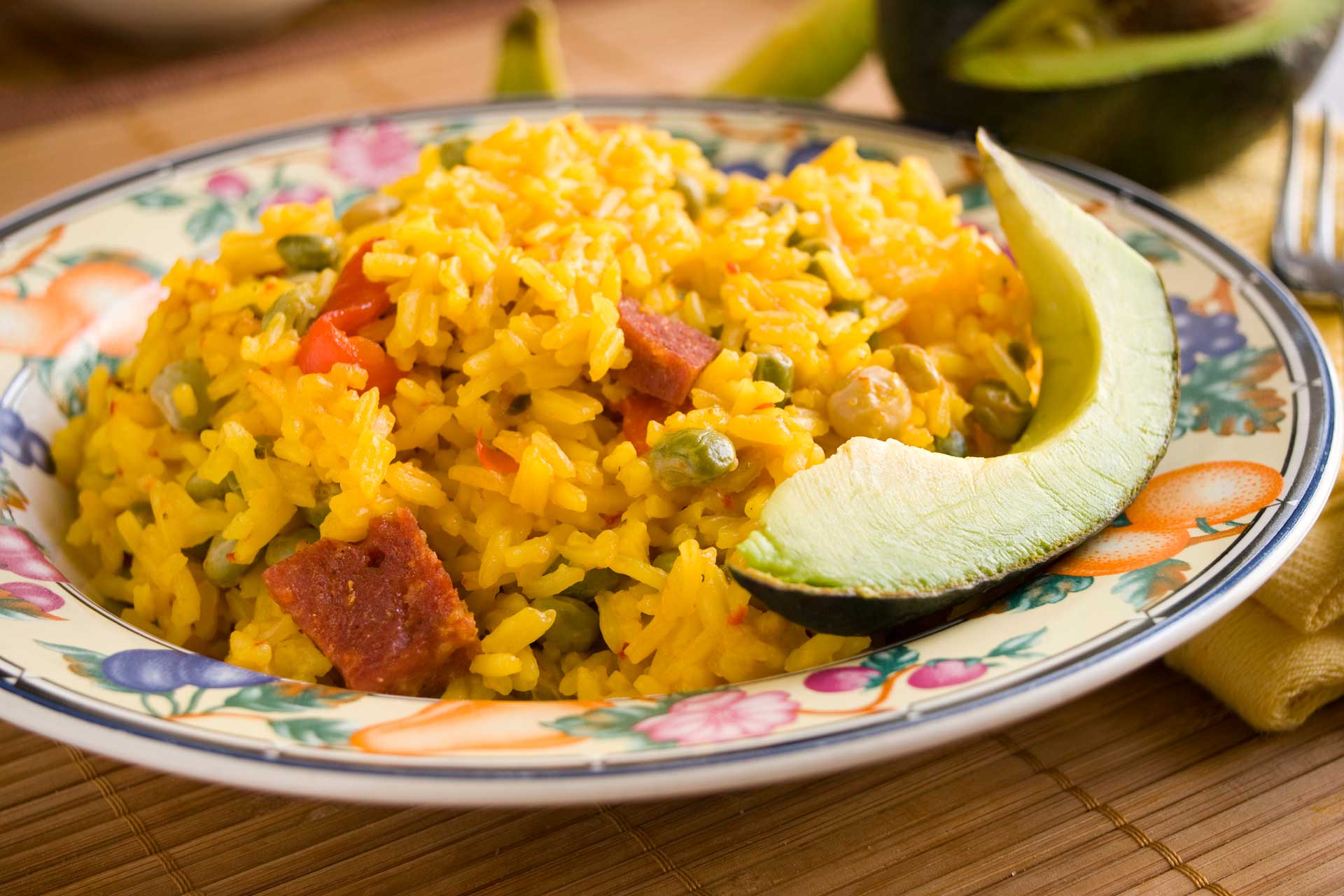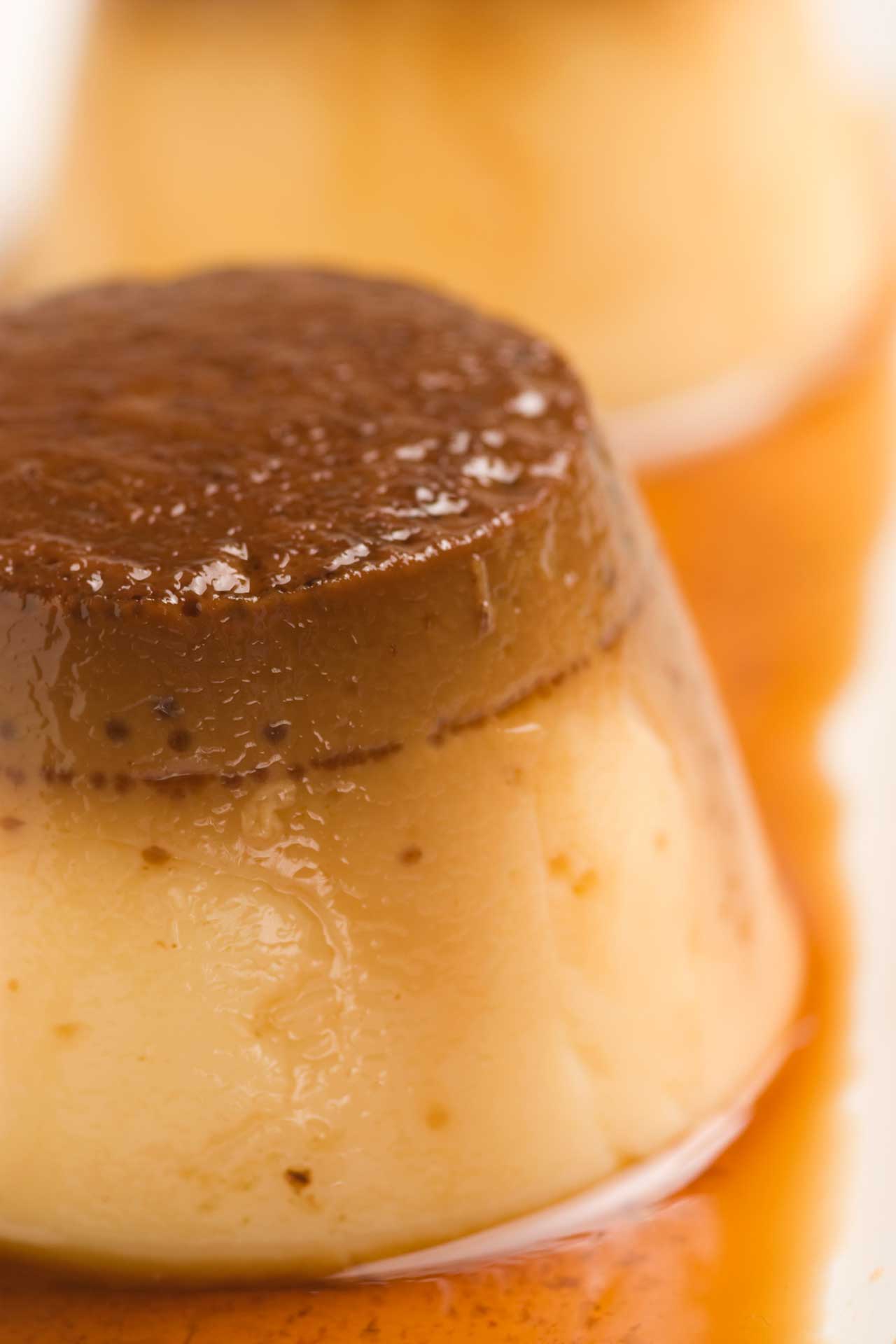Puerto Rican Cuisine

Although Puerto Rican cooking is often compared to Spanish, Cuban and Mexican cuisine, it is a unique tasty blend of Spanish, African, Taíno, and American influences, using such indigenous seasonings and ingredients as coriander, papaya, cacao, nispero, apio, plantains, and yampee. Locals call their cuisine "cocina criolla".
Cocina criolla (Créole cooking) can be traced back to the Arawaks and Tainos, the original inhabitants of the island, who thrived on a diet of corn, tropical fruit, and seafood. When Ponce de León arrived with Columbus in 1493, the Spanish added beef, pork, rice, wheat, and olive oil to the island's foodstuffs. Soon after, the Spanish began planting sugarcane and importing slaves from Africa, who brought with them okra and taro (known in Puerto Rico as yautia). The mingling of flavors and ingredients passed from generation to generation among the different ethnic groups that settled on the island, resulting in the exotic blend of today's Puerto Rican cuisine.
Appetizers & Soups
Lunch and dinner generally begin with sizzling-hot appetizers such as bacalaitos, crunchy cod fritters; surullitos, sweet plump cornmeal fingers; and empanadillas, crescent-shaped turnovers filled with lobster, crab, conch, or beef.
Soups are a popular beginning for meals on Puerto Rico. There is a debate about whether one of the best-known soups, frijoles negros (black-bean soup), is Cuban or Puerto Rican in origin. Nevertheless, it is still a savory, if filling, opening to a meal.
Another classic soup is sopón de pollo con arroz -chicken soup with rice- which manages to taste somewhat different in every restaurant. One traditional method of preparing this soup calls for large pieces of pumpkin and diced potatoes or yautias (the starchy root of a large-leaved tropical plant whose flesh is usually yellow or creamy white).
The third classic soup is sopón de pescado (fish soup), prepared with the head and tail intact. Again, this soup varies from restaurant to restaurant and may depend on the catch of the day. Traditionally, it is made with garlic and spices plus onions and tomatoes, the flavor enhanced by a tiny dash of vinegar and a half cup of sherry. Galician broth (caldo gallego) is a dish imported from Spain's northwestern province of Galicia. It is prepared with salt pork, white beans, ham, and berzas (collard greens) or grelos (turnip greens), and the whole kettle is flavored with spicy chorizos (Spanish sausages).

Arroz con Gandules
Garbanzos (chickpeas), are often added to give flavor, body, and texture to Puerto Rican soups. One of the most authentic versions of this is sopón de garbanzos con patas de cerdo (chickpea soup with pig's feet). Into this kettle is added a variety of ingredients, including pumpkin, chorizos, salt pork, chile peppers, cabbage, potatoes, tomatoes, and fresh cilantro leaves.
Not really a soup, the most traditional Puerto Rican dish is asopao, a hearty gumbo made with either chicken or shellfish. One well-known version, consumed when the food budget runs low, is asopao de gandules (pigeon peas). Every Puerto Rican chef has his or her own recipe for asopao. Asopao de pollo (chicken asopao) takes a whole chicken, which is then flavored with spices such as oregano, garlic, and paprika, along with salt pork, cured ham, green peppers, chile peppers, onions, cilantro, olives, tomatoes, chorizos, and pimientos. For a final touch, green peas or asparagus might be added.
Main Dishes
The aroma that wafts from kitchens throughout Puerto Rico comes from adobo and sofrito -blends of herbs and spices that give many of the native foods their distinctive taste and color. Adobo, made by crushing together peppercorns, oregano, garlic, salt, olive oil, and lime juice or vinegar, is rubbed into meats before they are roasted. Sofrito, a potpourri of onions, garlic, coriander, and peppers browned in either olive oil or land and colored with achiote (annatoo seeds), imparts the bright-yellow color to the island's rice, soups, and stews.
Stews loom large in the Puerto Rican diet. They are usually cooked in a caldero or heavy kettle. A popular one is carne guisada puertorriqueña; (Puerto Rican beef stew). The ingredients that flavor the chunks of beef vary according to the cook's whims or whatever happens to be in the larder. These might include green peppers, sweet chile peppers, onions, garlic, cilantro, potatoes, olives stuffed with pimientos, or capers. Seeded raisins may be added on occasion. Meat pies (pastelón de carne) are the staple of many Puerto Rican dinners. Salt pork and ham are often used for the filling and are cooked in a caldero. This medley of meats and spices is covered with a pastry top and baked.
Other typical main dishes include fried beefsteak with onions (carne frita con cebolla), veal (ternera) a la parmesana, and roast leg of pork, fresh ham, lamb, or veal, a la criolla. These roasted meats are cooked in the Créole style, flavored with adobo.
Puerto Ricans also like such dishes as breaded calfs brains (sesos empanados), calfs kidney (riñones guisados), and stuffed beef tongue (lengua rellena).
A festive island dish is lechón asado, or barbecued pig, which is usually cooked for a party of 12 or 15. It is traditional for picnics and al fresco parties; one can sometimes catch the aroma of this dish wafting through the palm trees, a smell that must have been familiar to the Taino peoples. The pig is basted with jugo de naranjas agría (sour orange juice) and achiote coloring. Green plantains are peeled and roasted over hot stones, then served with the barbecued pig as a side dish. The traditional dressing served with the pig is ali-li-monjili, a sour garlic sauce. The sauce combines garlic, whole black peppercorns, and sweet seeded chile peppers, flavored further with vinegar, lime juice, and olive oil.
Puerto Ricans adore chicken, which they flower various spices and seasoning. Arroz con pollo (chicken with rice) is the most popular chicken dish on the island, and it was brought long ago to the U.S mainland. Other favorite preparations include chicken in sherry (pollo al jerez), pollo agridulce (sweet and sour chicken), and pollitos asados a la parrilla (broiled chickens).
Most visitors to the island seem to like the fish and shellfish. A popular fried fish with Puerto Rican sauce (mojo isleño). The sauce is made with olives and olive oil, onions, pimientos, capers, tomato sauce, vinegar, and a flavoring of garlic and bay leaves. Fresh fish is often grilled, and perhaps flavored with garlic and an overlay of freshly squeezed lime juice -a very tasty dinner indeed. Caribbean lobster is usually the most expensive item on any menu, followed by shrimp. Puerto Ricans often cook shrimp in beer (camarones en cerveza). Another delectable shellfish dish is boiled crab (jueyes hervidos).

Tostones
Many tasty egg dishes are served, especially tortilla española (Spanish omelet), cooked with finely chopped onions, cubed potatoes, and olive oil.
The rich and fertile fields of Puerto Rico produce a wide variety of vegetables. A favorite is the chayote, a pear-shaped vegetable called christophone throughout most of the English-speaking Caribbean. Its delicately flavored flesh is often compared to that of summer squash. Breadfruit, prepared in a number of ways, frequently accompanies main dishes. This large, round fruit from a tropical tree has a thick green rind covering its starchy, sweet flesh. The flavor is evocative of a sweet potato. Tostones -fried green breadfruit slices- accompany most meat, fish, or poultry dishes served on the island.
Tostones may also be made with plantains. In fact, the plantains seems to be the single most popular side dish served on the island. Plantains are a variety of banana that cannot be eaten raw. They are much coarser in texture that ordinary bananas and are harvested while green, then baked, fried, or boiled. When made into tostones, they are usually served as a appetizer with before-dinner drinks. Fried to a deep golden-yellow, plantains may accompany fish, meat, or poultry dishes.
Interesting Fact
Plantains are an important crop in many agricultural sectors of the
island. However, demand is so high that many plantains are also imported,
usually from the Dominican Republic and Costa Rica.
Desserts

Flan
Desserts usually include some form of flan (custard) or perhaps nisperos de batata (sweet-potato balls with coconut, cloves and cinnamon). Equally traditional would be a portion of guava jelly with queso blanco (white cheese). Chefs take the bountiful harvest of Puerto Rican fruits and create any number of desserts, including orange layer cake, banana cupcakes, and guava cake. The most delicious dessert may be a freshly prepared fruit cocktail. the pumpkin, which grows in abundance on Puerto Rico, is used not only to flavor soups and as a side vegetable, but also to make the succulent base of a traditional Puerto Rican cake. Similarly, the sweet potato is used both as a side vegetable and in making a regional sweet-potato cake.
Coconut is probably the most common dessert ingredient. Many delectable desserts are made with its milk (leche de coco), including coconut flan, coconut cream desserts, crunchy coconut squares, coconut with meringue, and candied coconut rice. Another classic preparation is coconut bread pudding (boudin de pasas con coco). Polvo de amor ("love powder") is prepared with grated coconut meat after the milk has been extracted. The coconut is mixed with a lot of sugar and placed in a kettle to cook rapidly, then served crisp and golden brown.
Puerto Ricans make a number of preserves and jellies. Both sweet and sour guavas are used for various concoctions -not only guava jelly, but guava shells in syrup, guava paste, and guava pudding. Papayas are made into preserved or desserts with sugar, cinnamon, and vanilla extract. A mango dessert is made with virtually the same ingredients. Mangoes may be used for mamey preserve (dulce de mamey) or may be consumed raw.
Drinks
Finish your meal with strong, black, aromatic Puerto Rican coffee, which has been produced in the island's high-altitude interior for more than 300 years. Originally imported from the nearby Dominican Republic, coffee is still among the island's exports and is a suitable ending for any well-presented meal.
Because the island does not produce wine, it is entirely proper to order a cold beer before even looking at the menu. Beer, of course, is called cerveza throughout the Spanish-speaking world, the most popular brand on Puerto Rico is Medalla.
Rum is the national drink, and you can buy it in almost any shade. Puerto Rico is the world's leading rum producer; 80% of the rum consumed in the United States hails from the island.
Today's rum bears little resemblance to the raw and grainy beverage consumed by the renegades and pirates of the Spanish Main. Christopher Columbus brought sugarcane, from which rum is distilled, to the Caribbean on his second voyage to the New World, and in virtually no time it became the regional drink.
It is believed that Ponce de León introduced rum to Puerto Rico during his governorship, which began in 1508. In time, there emerged large sugarcane plantations. From Puerto Rico and other West Indian islands, rum was shipped to colonial America, where it lent itself to such popular and hair-raising 18th-century drinks as Kill-Divil and Whistle-Belly Bengance. After America became a nation, rum was largely displaced as the drink of choice by whiskey, distilled from grain grown on the American plains.
It took almost a century before the rum industry regained its former vigor. This occurred during a severe whiskey shortage at the end of the World War II. By the 1950s, sales of rum had fallen off again, as more and different kinds of liquor became available on the U.S. market. Rum had been a questionable drink because of inferior distillation methods and quality. Recognizing this problem, the Puerto Rican government drew up rigid standards for producing, blending, and aging rum. Rum factories were outfitted with the most modern and sanitary equipments, and sales figures (encouraged by aggressive marketing campaign) began to climb.
The color of rum is usually gold, amber, or white. The lightest, driest rum is white. It can easily replace gin or vodka in dozens of mixed drinks that are eminently suited for consumption in the tropics. Many Puerto Ricans make Bloody Marys with rum instead of gin or vodka. The robust flavors of the gold or amber rums make them an effective substitute for whiskey. Whit white (clear) rum, orange juice and tonic water are the most popular mixers; amber rum is often served on the rocks. Puerto Ricans are fond of mixing it with various cola drinks. Gold rums, aged between four and six years (sometimes longer) in wooden casks are called ánejos. They are considered the most flavorful and distinctive on the island rums. They are smooth; drink them straight or on the rocks.
Bacardi is the Puerto Rican rum most widely consumed in the United States. It is followed by other popular brands, including, Ronrico, Castillo, and Don Q. The ánejos rums carry such labels as Bacardi Gold Reserve, Ron del Barrilito, and Seralles' El Dorado.

Your best introduction to Puerto Rican rum making is to visit the Bacardi distillery in Cataño, just a short ferry-boat ride across the San Juan harbor.
Each bartender worthy of the profession in Puerto Rico likes to concoct his or her own favorite rum libation. Every resort offers the piña colada, which is made with cream of coconut, white Puerto Rican rum, and canned pineapple juice. the ingredients are thoroughly blended and served frappé-style in a tall cool glass, usually garnished with a maraschino cherry and a small paper parasol. But you may want to be more adventurous and sample some of the island's other cocktails, many of which are made with fresh fruit juices. Planter's punch, served over cracked ice, is the second most popular mixed rum drink for tourists. Often, it combines dark Puerto Rican rum, dark-brown Jamaican rum, citrus juice, and Angostura bitters. Of course, you can substitute rum in many mixed drinks such as rum collins, rum sour, rum screwdriver, and rum and tonic. The classic sangría, which is prepared in Spain with dry red wine, sugar, orange juice, and other ingredients, may be given a thoroughly Puerto Rican twist with a hefty dose of the island's rum.
Spotlight
Piraguas: A shaved ice cone covered with syrup of fruity flavors such as: rasberry, pineapple, coconut, guava or tamarind, among others. Those who sells "piraguas" are known as piragüeros. You can find them near plazas in small carts creatively painted with bright colors.
Want to indulge and try more Puerton Rican Recipes?
Cocina criolla
is my favorite Puerto Rican recipe book. My mother gifted me a copy on my 18th birthday, since then,
it has been my staple recipe book ever since.
You can find few other
great Puerto Rican recipe books online.
Other Resources



